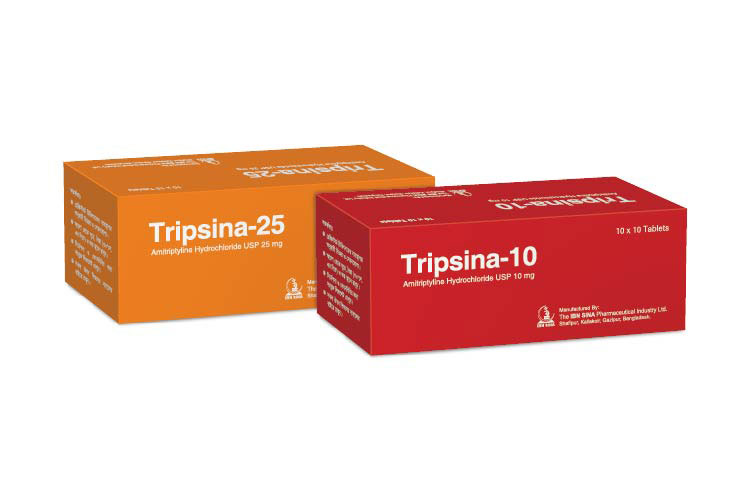
TRIPSINA
AMITRIPTYLINE HYDROCHLORIDE BP
| NAME | STRENGTH | PACK SIZE | DOSAGE FORM |
|---|---|---|---|
| TRIPSINA-10 TABLET | 10 MG | 100 S | TABLET |
| TRIPSINA-25 TABLET | 25 MG | 100 S | TABLET |
Tripsina 10 tablet: Each film coated tablet contains Amitriptyline Hydrochloride USP 10 mg.
Trisina (Amitriptyline) is a tricyclic antidepressant. It has marked anticholinergic and sedative properties. It prevents the reuptake of noradrenaline and serotonin at nerve ending. Amitriptyline hydrochloride is rapidly absorbed from the GI tract. Peak plasma concentrations occur within 2-12 hours. Amitriptyline is excreted in the urine, mainly in the form of its metabolites.
Tripsina is indicated for Depressive Illness: particularly where sedation is required, Nocturnal Enuresis in children, Prophylaxis of Migraine, Tension Headache a, Neuropathic pain, Abdominal pain and, Chronic Pain.
Depression:
Initially 75 mg (Elderly and Adolescents 30-75 mg) daily in divided doses or as a single dose at bedtime increased gradually as necessary to 150-200 mg; Child under 16 years not recommended for depression.
Nocturnal Enuresis:
Child 6-10 years: 10-20 mg, 11-16 years: 25-50 mg at night; max. period of treatment (including gradual withdrawal) 3 months-full physical examination before the further course.
Neuropathic pain & Migraine Prophylaxis:
The recommended initial dose is 10-25 mg in the evening.
Tension Headache:
10-25 mg three times daily.
Abdominal pain:
Initially 5-10 mg daily.
Amitriptyline is contraindicated in myocardial infarction, arrythmias, particularly heart block of any degree, mania and severe liver disease. Initially, sedation may affect the ability to drive or operate machinery.
It should be used with caution in patients with a history of epilepsy, glaucoma, urinary retention, cardiac disease, diabetes, pregnancy, hepatic impairment, thyroid disease, increased intra-ocular pressure and psychoses (may aggravate mania).
Anticholinergic: Excessive perspiration, dry mouth, blurred vision, hyperpyrexia, urinary retention and urinary tract dilatation. Cardiovascular reactions: Hypotension, syncope, postural hypotension, hypertension, tachycardia, palpitations, myocardial infarction, etc. CNS and Neuromuscular: Confusional states, disturbed concentration, disorientation, delusions, etc. Allergic: Skin rash, urticaria, photosensitization, etc.
Haematological: Bone-marrow depression. Gastrointestinal: Nausea, epigastric distress, vomiting, anorexia, stomatitis, unpleasant taste, weight loss, diarrhoea, constipation, etc. Endocrine: Testicular swelling, gynaecomastia, breast enlargement, galactorrhoea, etc.
Pregnancy Category C. Amitriptyline has been shown to cross the placenta. Amitriptyline should be used during pregnancy only if the potential benefit to the mother justifies the potential risk to the fetus. Amitriptyline is excreted into breast milk. Because of the potential for serious adverse reactions in nursing infants from Amitriptyline, a decision should be made whether to discontinue nursing or to discontinue the drug, taking into account the importance of the drug to the mother.
TCA enhances the sedative effect of alcohol and opioid analgesics. When TCA is used with Moxifloxacin or Terfenadine, it increases the risk of ventricular arrhythmias. Disulfirum and Cimetidine inhibit the metabolism of Amitriptyline. When TCA is used with diuretics, it enhances the risk of postural hypotension.
N/A
Protect from light and moisture, keep in a cool and dry place. Store below 30° C. Keep the medicine out of reach of children.
Tripsina 10 tablet: Each box contains 20 x 10 film coated tablets in strip pack.
